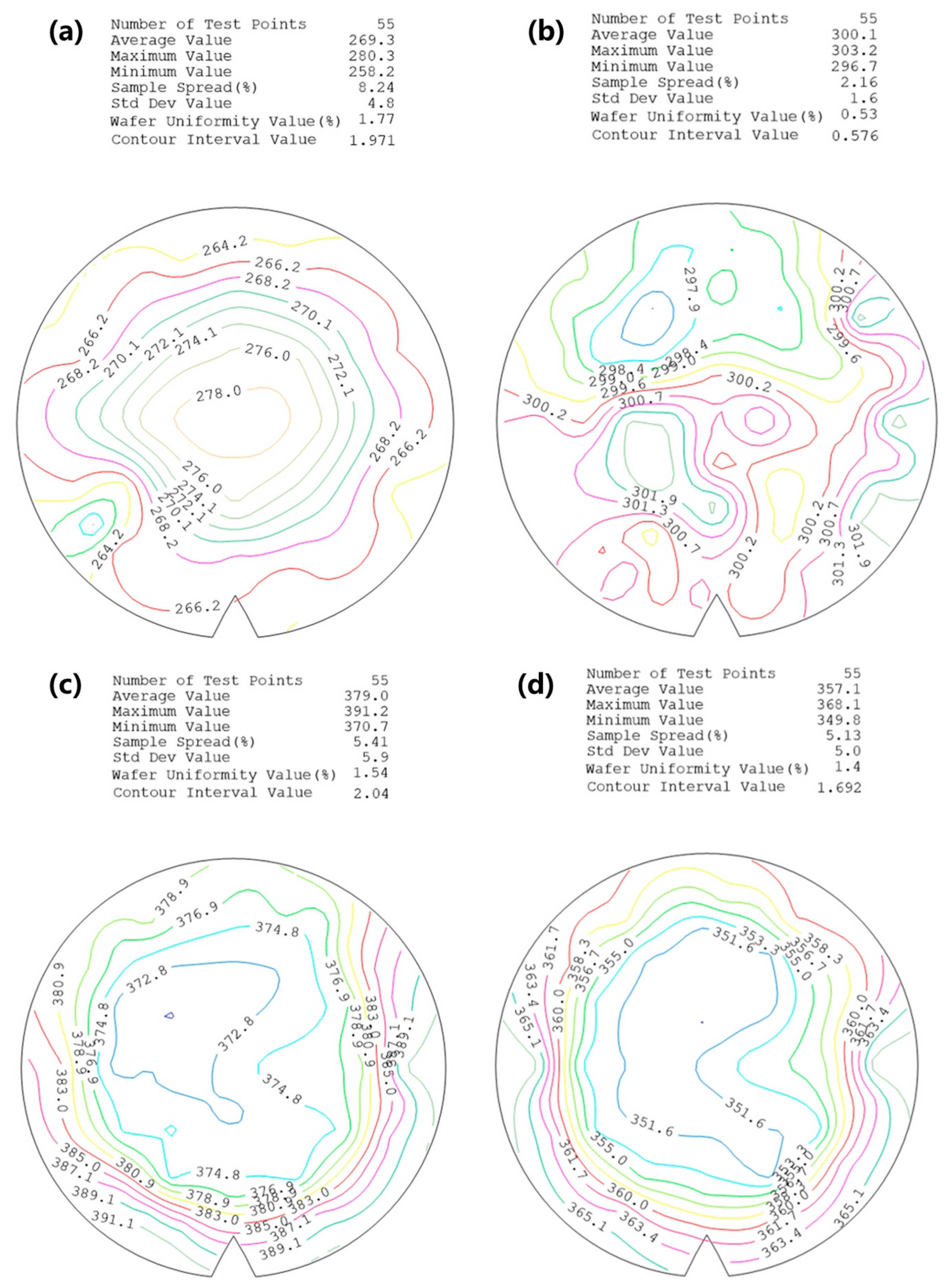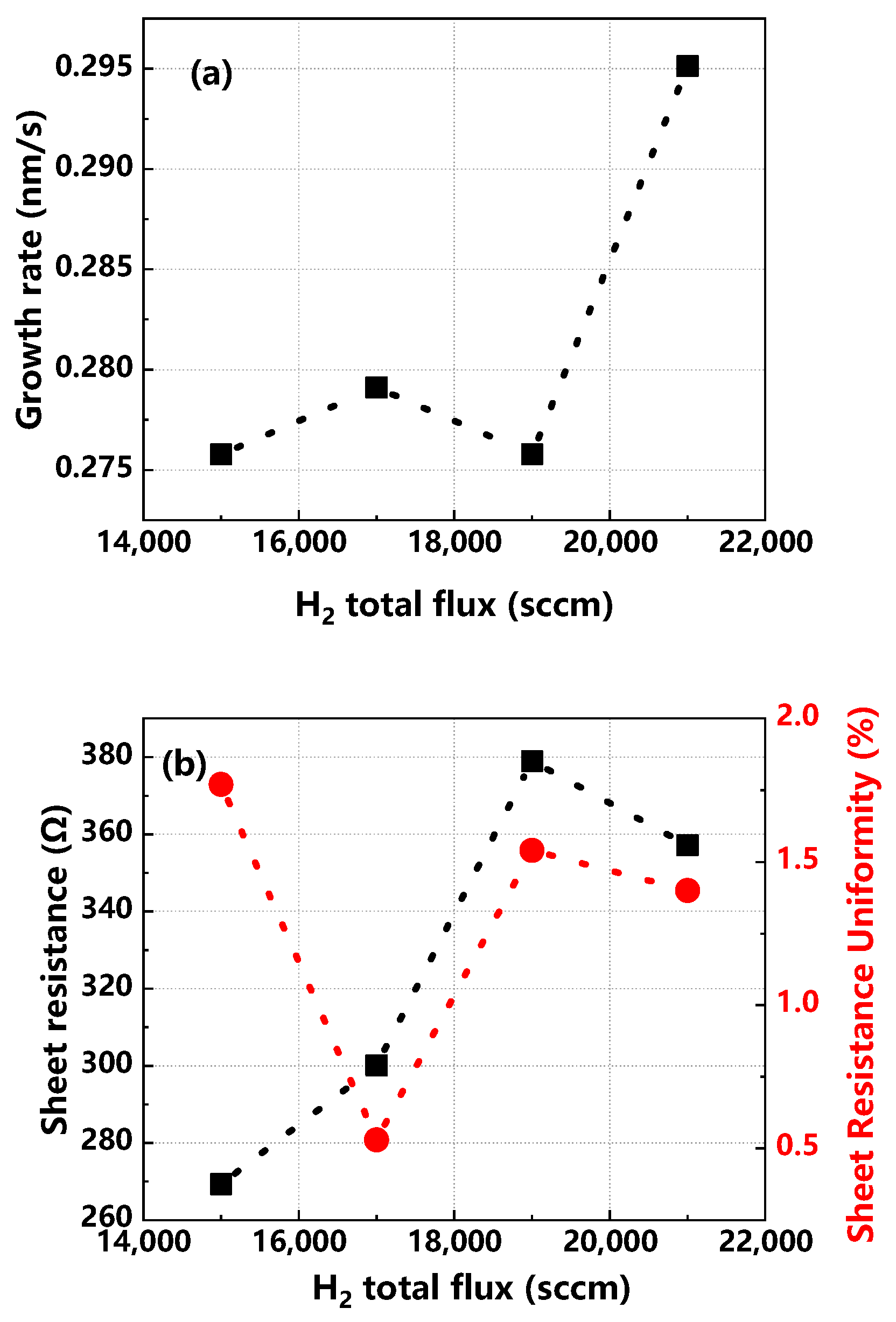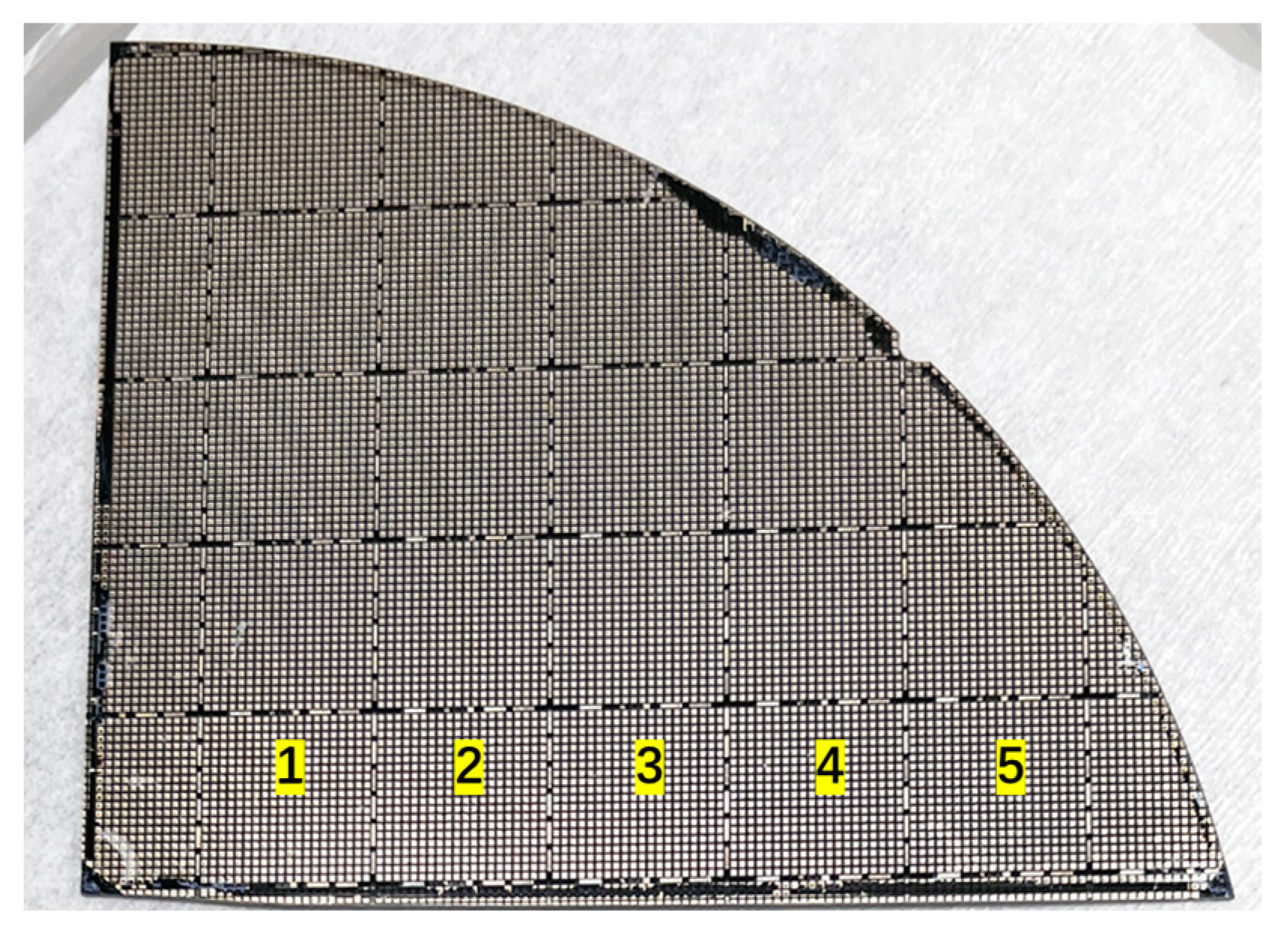Investigation of Hydrogen Flux Influence on InGaP Layer and Device Uniformity
Abstract
:1. Introduction
2. Materials and Methods
3. Results and Discussion
3.1. Influence of Total H2 Flux on the Uniformity of the InGaP Single Layer
3.2. Impact of Total H2 Flux on the Uniformity of InGaP/GaAs HBTs
3.2.1. Gummel Curve Measurements
3.2.2. IV Output Curve Measurements
3.2.3. Breakdown Voltage Curve Measurements
4. Conclusions
Author Contributions
Funding
Data Availability Statement
Conflicts of Interest
References
- Yang, Y.-C.; Wan, Z.; Hsu, G.-T.; Chiu, C.-C.; Chen, W.-H.; Feifel, M.; Lackner, D.; Xia, G.; Wu, C.-H. 25 Gb/s NRZ Transmission at 85 °C Using a High-Speed 940 Nm AlGaAs Oxide-Confined VCSEL Grown on a Ge Substrate. Opt. Lett. 2024, 49, 586. [Google Scholar] [CrossRef] [PubMed]
- Wan, Z.; Yang, Y.-C.; Chen, W.-H.; Chiu, C.-C.; Zhao, Y.; Feifel, M.; Chrostowski, L.; Lackner, D.; Wu, C.-H.; Xia, G. Monolithically Integrated 940 Nm VCSELs on Bulk Ge Substrates. Opt. Express 2024, 32, 6609. [Google Scholar] [CrossRef] [PubMed]
- Xie, S.; Sheikhi, M.; Xu, S.; Alam, M.T.; Zhou, J.; Mawst, L.; Ma, Z.; Gupta, C. P-GaAs/n-Ga2O3 Heterojunction Diode with Breakdown Voltage of ∼800 V. Appl. Phys. Lett. 2024, 124, 073503. [Google Scholar] [CrossRef]
- Singh, S.; Samajdar, D.P.; Dutta, K. Systematic Investigation of the Optical Characteristics of GaAs Solar Cells with Antireflection Coatings and Metallic Nanoparticles Using Finite Element Analysis. ACS Appl. Electron. Mater. 2024, 6, 1600–1616. [Google Scholar] [CrossRef]
- Liu, Y.; Ma, Y.; Guo, H.; Fu, S.; Liu, Y.; Wei, G.; Liu, Y.; Hao, Y.; Chen, D. The Study of N-Polar GaN/InAlN MOS-HEMT and T-Gate HEMT Biosensors. J. Phys. D Appl. Phys. 2024, 57, 075107. [Google Scholar] [CrossRef]
- France, R.M.; McMahon, W.E.; Guthrey, H.L. Critical Thickness of Atomically Ordered III-V Alloys. Appl. Phys. Lett. 2015, 107, 151903. [Google Scholar] [CrossRef]
- Steiner, M.A.; Bhusal, L.; Geisz, J.F.; Norman, A.G.; Romero, M.J.; Olavarria, W.J.; Zhang, Y.; Mascarenhas, A. CuPt Ordering in High Bandgap GaxIn1−xP Alloys on Relaxed GaAsP Step Grades. J. Appl. Phys. 2009, 106, 063525. [Google Scholar] [CrossRef]
- Li, J.H.; Forrest, R.L.; Moss, S.C.; Zhang, Y.; Mascarenhas, A.; Bai, J. Determination of the Order Parameter of CuPt- B Ordered GaInP2 Films by x-Ray Diffraction. J. Appl. Phys. 2002, 91, 9039–9042. [Google Scholar] [CrossRef]
- Schulte, K.L.; Diercks, D.R.; Roberts, D.M.; Dippo, P.C.; Packard, C.E.; Simon, J.; Ptak, A.J. Effect of Hydride Vapor Phase Epitaxy Growth Conditions on the Degree of Atomic Ordering in GaInP. J. Appl. Phys. 2020, 128, 025704. [Google Scholar] [CrossRef]
- Attolini, G.; Bocchi, C.; Germini, F.; Pelosi, C.; Parisini, A.; Tarricone, L.; Kùdela, R.; Hasenohrl, S. Effects of Inhomogeneities and Ordering in InGaP/GaAs System Grown by MOVPE. Mater. Chem. Phys. 2000, 66, 246–252. [Google Scholar] [CrossRef]
- France, R.M.; McMahon, W.E.; Kang, J.; Steiner, M.A.; Geisz, J.F. In Situ Measurement of CuPt Alloy Ordering Using Strain Anisotropy. J. Appl. Phys. 2014, 115, 053502. [Google Scholar] [CrossRef]
- Zakaria, A.; Fetzer, C.M.; Goorsky, M.S. Influence of the Degree of Order of InGaP on Its Hardness Determined Using Nanoindentation. J. Appl. Phys. 2010, 108, 074908. [Google Scholar] [CrossRef]
- Ferrini, R.; Guizzetti, G.; Patrini, M.; Parisini, A.; Tarricone, L.; Valenti, B. Optical Functions of InGaP/GaAs Epitaxial Layers from 0.01 to 5.5 eV. Eur. Phys. J. B-Condens. Matter 2002, 27, 449–458. [Google Scholar] [CrossRef]
- Longo, M.; Parisini, A.; Tarricone, L.; Toni, L.; Kúdela, R. Photoluminescence Investigation of Superlattice Ordering in Organometallic Vapour Phase Epitaxy Grown InGaP Layers. Mater. Sci. Eng. B 2001, 86, 157–164. [Google Scholar] [CrossRef]
- Martín, G.; Coll, C.; López-Conesa, L.; Rebled, J.M.; Barrigón, E.; García, I.; Rey-Stolle, I.; Algora, C.; Cornet, A.; Estradé, S.; et al. Understanding the Anisotropy in the Electrical Conductivity of CuPtB-Type Ordered GaInP Thin Films by Combining In Situ TEM Biasing and First Principles Calculations. ACS Appl. Electron. Mater. 2022, 4, 3478–3485. [Google Scholar] [CrossRef] [PubMed]
- Park, G.Y.; Kim, C.W.; Kim, H.J. A Study on Epitaxial Lift-Off in InGaP/GaAs Double-Junction Solar Cells via Au-Au Bonding on Pre-Patterned Area. IEEE Photonics J. 2022, 14, 1–5. [Google Scholar] [CrossRef]
- Oh, H.; Shin, J.; Jeon, H.; Woo, Y.Y.; Hwang, K.C.; Lee, K.-Y.; Yang, Y. Broadband InGaP/GaAs HBT Doherty Power Amplifier IC Using Direct Interstage Power Division for Compact 5G NR Handset Module. IEEE Access 2023, 11, 25879–25892. [Google Scholar] [CrossRef]
- Liu, Z.; Zhu, H.; Pan, X.; Huang, Y. Burn-in Effect in InGaP/GaAs HBT with Intrinsically or Extrinsically Carbon Doped Base Layer. Phys. Scr. 2023, 98, 065009. [Google Scholar] [CrossRef]
- Bauhuis, G.J.; Trinito, V.; Mulder, P.; Schermer, J.J. Characterization of Interface Recombination Velocity in GaAs/InGaP Heterojunction Solar Cells Using Dark Curve Measurements. IEEE J. Photovolt. 2022, 12, 754–759. [Google Scholar] [CrossRef]
- Wu, Y.-C.; Tsai, J.-H.; Chiang, T.-K.; Wang, F.-M. Comparative Investigation of InGaP/GaAs/GaAsBi and InGaP/GaAs Heterojunction Bipolar Transistors. Semiconductors 2015, 49, 1361–1364. [Google Scholar] [CrossRef]
- Nakamura, T.; Imaizumi, M.; Sato, S.; Ohshima, T.; Akiyama, H.; Okada, Y. Differences in Radiation Damage to Carrier Lifetimes in the Neutral and Depletion Regions of InGaP and GaAs Solar Cells. J. Appl. Phys. 2022, 132, 115701. [Google Scholar] [CrossRef]
- Mao, Q.; Huang, L.; Xiang, Z.; Zhu, D.; Meng, J. High-Power Microwave Pulse Induced Failure on InGaP/GaAs Heterojunction Bipolar Transistor. Microelectron. Reliab. 2022, 139, 114848. [Google Scholar] [CrossRef]
- Hashem, I.E.; Zachary Carlin, C.; Hagar, B.G.; Colter, P.C.; Bedair, S.M. InGaP-Based Quantum Well Solar Cells: Growth, Structural Design, and Photovoltaic Properties. J. Appl. Phys. 2016, 119, 095706. [Google Scholar] [CrossRef]
- Asami, M.; Watanabe, K.; Nakano, Y.; Sugiyama, M. Smooth Surface Morphology and Long Carrier Lifetime of InGaP Realized by Low-Temperature-Grown Cover Layer. Phys. Status Solidi B 2022, 259, 2100305. [Google Scholar] [CrossRef]
- Huang, C.H.; Tan, S.W.; Lo, H.; Lo, C.; Lour, W.S. Temperature Dependence of Sensing Properties of Hydrogen-Sensitive Extended-Base Heterojunction Bipolar Transistors. Int. J. Hydrogen Energy 2022, 47, 39276–39287. [Google Scholar] [CrossRef]
- Zhu, L.; Wang, Y.; Pan, X.; Akiyama, H. Theoretical Modeling and Ultra-Thin Design for Multi-Junction Solar Cells with a Light-Trapping Front Surface and Its Application to InGaP/GaAs/InGaAs 3-Junction. Opt. Express 2022, 30, 35202. [Google Scholar] [CrossRef] [PubMed]
- Orzali, T.; Vert, A.; O’Brian, B.; Herman, J.L.; Vivekanand, S.; Papa Rao, S.S.; Oktyabrsky, S.R. Epitaxial Growth of GaSb and InAs Fins on 300 Mm Si (001) by Aspect Ratio Trapping. J. Appl. Phys. 2016, 120, 085308. [Google Scholar] [CrossRef]
- Orzali, T.; Vert, A.; Kim, T.-W.; Hung, P.Y.; Herman, J.L.; Vivekanand, S.; Huang, G.; Kelman, M.; Karim, Z.; Hill, R.J.W.; et al. Growth and Characterization of an In0.53Ga0.47As-Based Metal-Oxide-Semiconductor Capacitor (MOSCAP) Structure on 300mm on-Axis Si (001) Wafers by MOCVD. J. Cryst. Growth 2015, 427, 72–79. [Google Scholar] [CrossRef]
- Heinecke, H.; Veuhoff, E.; Pütz, N.; Heyen, M.; Balk, P. Kinetics of GaAs Growth by Low Pressure MO-CVD. JEM 1984, 13, 815–830. [Google Scholar] [CrossRef]
- Qin, B.; Ma, H.; Hossain, M.; Zhong, M.; Xia, Q.; Li, B.; Duan, X. Substrates in the Synthesis of Two-Dimensional Materials via Chemical Vapor Deposition. Chem. Mater. 2020, 32, 10321–10347. [Google Scholar] [CrossRef]
- Tsang, W.T. The Growth of GaAs, AIGaAs, InP and InGaAs by Chemical Beam Epitaxy Using Group III and V Alkyls. J. Electron. Mater. 1986, 15, 235–245. [Google Scholar] [CrossRef]
- Yu, D.; Shen, S.; Li, H.; Shen, W. Design Optimization of Gas Distribution System for Large-Scale Capacity GaAs-MOCVD. Cryst. Res. Technol. 2023, 58, 2300186. [Google Scholar] [CrossRef]
- Sodabanlu, H.; Ubukata, A.; Watanabe, K.; Sugaya, T.; Nakano, Y.; Sugiyama, M. High-Speed MOVPE Growth of InGaP Solar Cells. IEEE J. Photovolt. 2020, 10, 480–486. [Google Scholar] [CrossRef]
- Hino, M.; Asami, M.; Watanabe, K.; Nakano, Y.; Sugiyama, M. InGaP Solar Cell with InGaP Multiple Quantum Wells Grown under Optimized V/III Ratio. Phys. Status Solidi A 2023, 220, 2300660. [Google Scholar] [CrossRef]
- Armani, N.; Abagnale, G.; Trespidi, F.; Cornelli, M.; Timò, G.; Malvisi, E.; Farina, F.; Carbi, G.; Rossi, F.; Fabbri, F.; et al. Low Growth Temperature MOCVD InGaP for Multi-Junction Solar Cells. Energy Procedia 2015, 84, 34–40. [Google Scholar] [CrossRef]
- Chuang, Y.-C.; Chen, C.-T. Mathematical Modeling and Optimal Design of an MOCVD Reactor for GaAs Film Growth. J. Taiwan Inst. Chem. Eng. 2014, 45, 254–267. [Google Scholar] [CrossRef]
- Féron, O.; Sugiyama, M.; Asawamethapant, W.; Futakuchi, N.; Feurprier, Y.; Nakano, Y.; Shimogaki, Y. MOCVD of InGaAsP, InGaAs and InGaP over InP and GaAs Substrates: Distribution of Composition and Growth Rate in a Horizontal Reactor. Appl. Surf. Sci. 2000, 159–160, 318–327. [Google Scholar] [CrossRef]
- Lin, Y.S.; Huang, D.H.; Chen, Y.W.; Huang, J.C.; Hsu, W.C. δ-Doped InGaP/GaAs Heterostructure-Emitter Bipolar Transistor Grown by Metalorganic Chemical Vapor Deposition. Thin Solid Film. 2007, 515, 3978–3981. [Google Scholar] [CrossRef]






| Sample No. | H2 Flux | Growth Temperature | V/III |
|---|---|---|---|
| Sample-a | 15,000 sccm | 650 °C | 80 |
| Sample-b | 17,000 sccm | ||
| Sample-c | 19,000 sccm | ||
| Sample-d | 21,000 sccm |
| Sample No. | H2 Flux | Growth Temperature | V/III |
|---|---|---|---|
| Sample-1 | 19,000 sccm | 650 °C | 80 |
| Sample-2 | 17,000 sccm | ||
| Sample-3 | 15,000 sccm |
| Measurement Content | Sample No. | 1 | 2 | 3 | 4 | 5 |
|---|---|---|---|---|---|---|
| Sample-1 | 59.9 | 60.6 | 61.7 | 62.5 | 50.6 | |
| Sample-2 | 58.3 | 57.9 | 57.7 | 57.6 | 57.1 | |
| Sample-3 | 54.9 | 55.5 | 54.4 | 52.6 | 53.1 | |
| (V) | Sample-1 | 2.19 | 1.84 | 2.08 | 2.08 | 1.70 |
| Sample-2 | 1.70 | 1.82 | 1.71 | 1.70 | 1.82 | |
| Sample-3 | 1.96 | 1.82 | 1.83 | 1.82 | 1.78 |
| Sample No. | Standard Deviation of | Standard Deviation of |
|---|---|---|
| Sample-1 | 0.20359 | 4.83070 |
| Sample-2 | 0.06244 | 0.46892 |
| Sample-3 | 0.07310 | 1.23464 |
| Measurement Content | 1 | 2 | 3 | 4 | 5 | Standard Deviation of (V) |
|---|---|---|---|---|---|---|
| 5.8 | 5.8 | 5.7 | 5.7 | 5.5 | 0.12249 | |
| 5.8 | 5.8 | 5.7 | 5.7 | 5.7 | 0.05477 | |
| 5.7 | 5.7 | 5.7 | 5.6 | 5.4 | 0.13039 |
Disclaimer/Publisher’s Note: The statements, opinions and data contained in all publications are solely those of the individual author(s) and contributor(s) and not of MDPI and/or the editor(s). MDPI and/or the editor(s) disclaim responsibility for any injury to people or property resulting from any ideas, methods, instructions or products referred to in the content. |
© 2024 by the authors. Licensee MDPI, Basel, Switzerland. This article is an open access article distributed under the terms and conditions of the Creative Commons Attribution (CC BY) license (https://creativecommons.org/licenses/by/4.0/).
Share and Cite
Yang, S.; Guo, N.; Zhao, S.; Li, Y.; Wei, M.; Zhang, Y.; Liu, X. Investigation of Hydrogen Flux Influence on InGaP Layer and Device Uniformity. Electronics 2024, 13, 2109. https://doi.org/10.3390/electronics13112109
Yang S, Guo N, Zhao S, Li Y, Wei M, Zhang Y, Liu X. Investigation of Hydrogen Flux Influence on InGaP Layer and Device Uniformity. Electronics. 2024; 13(11):2109. https://doi.org/10.3390/electronics13112109
Chicago/Turabian StyleYang, Shangyu, Ning Guo, Siqi Zhao, Yunkai Li, Moyu Wei, Yang Zhang, and Xingfang Liu. 2024. "Investigation of Hydrogen Flux Influence on InGaP Layer and Device Uniformity" Electronics 13, no. 11: 2109. https://doi.org/10.3390/electronics13112109






